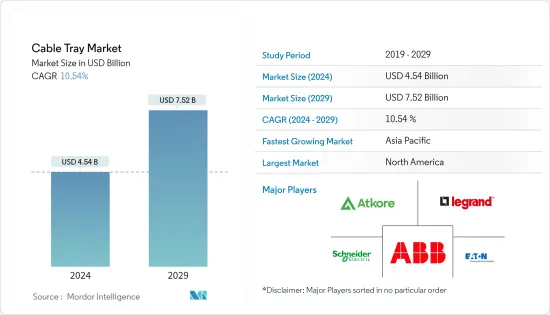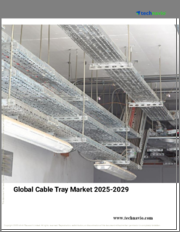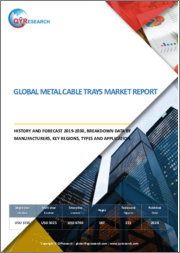
|
시장보고서
상품코드
1549957
케이블 트레이 - 시장 점유율 분석, 산업 동향 및 통계, 성장 예측(2024-2029년)Cable Tray - Market Share Analysis, Industry Trends & Statistics, Growth Forecasts (2024 - 2029) |
||||||
케이블 트레이 시장 규모는 2024년 45억 4,000만 달러로 추정되며, 2029년에는 75억 2,000만 달러에 달할 것으로 예상되며, 예측 기간(2024-2029년) 동안 10.54%의 CAGR로 성장할 것으로 예상됩니다.

주요 하이라이트
- 케이블 트레이는 건물 및 산업 환경에서 배전, 통신, 제어용 케이블을 지지하고 정리하는 구조 시스템입니다. 전 세계적으로 건설 프로젝트가 급증함에 따라 케이블 트레이와 같은 효율적인 케이블 관리의 필요성이 증가하고 있습니다. 이러한 수요는 도시화와 인프라의 발전으로 인해 더욱 가속화되고 있습니다. 또한, 안전 표준 및 규정 준수를 촉진하여 케이블 트레이를 강화하는 데 주력하고 있습니다.
- 디지털 데이터의 증가는 데이터센터의 수요 급증에 박차를 가하고 있습니다. 이러한 센터에서는 네트워크 케이블, 배전 및 광섬유를 관리할 수 있는 효율적인 솔루션을 제공하는 케이블 트레이가 중요한 역할을 하고 있습니다. 클라우드 컴퓨팅 서비스가 확대되고 데이터 스토리지에 대한 수요가 증가함에 따라 데이터센터는 이러한 광범위한 케이블 배선 솔루션에 대한 의존도가 점점 더 높아지고 있습니다.
- 2023년 JLL 보고서에 따르면, 개발 중인 하이퍼스케일 사이트는 전 세계 314곳으로 데이터센터 기술이 크게 도약하고 있으며, 2024년 말까지 이 숫자는 1,000곳을 넘어 불과 5년 전 약 500곳에서 두 배로 증가할 것으로 예상됩니다. 미국이 하이퍼스케일 발전에서 선두를 유지할 것으로 예상되지만, 중국, 아일랜드, 인도, 스페인, 이스라엘, 캐나다, 이탈리아, 호주, 영국 등의 국가들도 눈에 띄는 성장세를 보이고 있습니다.
- 케이블 트레이 설치에는 특수 장비, 숙련 된 인력, 정확한 측정 및 고유 한 기술이 필요합니다. 이러한 시스템에는 손목 스트랩, 바디 마운트, 벽면 마운트, 패스너 및 지지대와 같은 보조 부품이 필요하므로 전체 비용이 증가합니다. 또한 원자력발전소, 건설 현장 및 대규모 프로젝트에서 케이블 트레이를 설치하려면 전용 시간, 장비 및 인력이 필요하기 때문에 건설이 지연되고 추가 비용이 발생하여 시장 성장을 저해할 수 있습니다.
- COVID-19 이후 클라우드 플랫폼으로의 전환이 진행되면서 클라우드 서비스가 확대되고, 하이퍼스케일 데이터센터에서는 대규모 케이블 배선 솔루션이 필요하게 되었습니다. 또한, 디지털 서비스에 대한 의존도가 높아지면서 데이터센터의 성장이 가속화되고 대규모 IT 인프라를 지원하는 케이블 트레이 시스템에 대한 수요가 증가하고 있습니다.
케이블 트레이 시장 동향
건설 부문이 큰 비중을 차지
- 건설 부문이 시장을 독점하고 있으며, 주로 정부 투자 인프라 프로젝트가 건설 활동을 촉진하고 있습니다. 이러한 건설의 급격한 증가로 인해 전기 및 통신 케이블을 관리하는 케이블 트레이에 대한 수요가 증가하고 있습니다. 또한 IoT 장치와 스마트 빌딩 기술을 통합하려는 경향이 높아짐에 따라 에너지 관리, 보안, 유지보수 및 거주자의 편안함을 향상시킬 수 있습니다. 이러한 추세는 케이블 트레이 시장의 성장을 더욱 촉진하고 있습니다.
- IoT 센서가 장착된 스마트 케이블 트레이는 케이블 상태를 실시간으로 모니터링할 수 있어 유지보수 및 운영 효율을 향상시킬 수 있습니다. 또한 고급 소프트웨어 도구와 로봇 공학을 통해 케이블 트레이의 설계 및 설치 자동화를 촉진할 수 있습니다.
- 2023년, 취리히가 세계에서 가장 스마트한 도시로 선정되었으며, 그 성공은 탄탄한 인프라, 지속가능성에 대한 헌신, 첨단 교통망 덕분이라고 주장했습니다. IBM은 취리히의 스마트 교통 관리 및 자전거 공유 프로그램부터 에너지 효율이 높은 건물에 이르기까지 취리히의 디지털 보안 및 대중교통에 대한 전문성을 강조하며, 취리히의 디지털 서비스를 통한 탁월한 시민 참여에 대해서도 언급했습니다. 디지털 서비스를 통한 탁월한 시민 참여에 주목했습니다.
- 지속가능하고 에너지 효율적인 프로젝트가 증가함에 따라 케이블 트레이 시스템은 지속가능한 재료와 디자인을 사용해야 합니다. 태양광 패널과 같은 재생에너지원을 통합하는 프로젝트는 추가적인 배선 요구 사항을 충족하기 위해 견고한 케이블 관리가 필요합니다. 예를 들어, 인도 정부는 2024년 중간 예산에서 재생에너지 부문을 강화하고 탄소 배출을 줄이기 위해 13억 8,000만 달러(약 11,500억 인도 루피) 이상을 배정했습니다. 이 자금은 태양광발전(그리드), 국가 녹색 수소 미션, 풍력 발전(그리드) 프로젝트에 할당되었으며, 2025년 3월까지 회계연도를 대상으로 합니다.
- 또한 전 세계적으로 현대식 공동주택의 건설이 증가하고 있으며, 인터넷, TV, 스마트 홈 시스템을 위한 종합적인 케이블 관리가 필요합니다. 일부 프로젝트는 전기를 위해 태양광 패널을 설치하기도 합니다. 따라서 태양광 모듈, 인버터, 충전 컨트롤러, 배터리 등을 연결하기 위해 다양한 케이블이 필요합니다. 케이블 트레이는 케이블의 엉킴을 방지하고 안전한 설치를 보장하기 위해 케이블을 정리하는 데 도움이 됩니다. 예를 들어, 국제에너지협회(IEA)에 따르면 2027년까지 전 세계 태양광발전의 재생 가능 전력 용량은 3329.5기가와트에 달할 것으로 예상됩니다.
아시아태평양이 큰 성장을 이룰 것
- 아시아태평양의 케이블 트레이 시장은 주로 견조한 건설 부문에 힘입어 향후 몇 년 동안 성장할 것으로 예상됩니다. 특히 중국, 인도, 동남아시아 및 기타 국가에서 건설 및 인프라에 대한 투자가 증가하고 있으며, 이는 케이블 관리 시스템에 대한 수요를 촉진하고 있습니다.
- 아시아태평양에서는 여러 시장이 5G 인프라를 구축하기 시작했습니다. 한국은 2019년 4월에 전국적인 5G 네트워크를 시작하여 세계 속도를 주도했습니다. 그 후 호주, 필리핀, 중국, 뉴질랜드가 그 뒤를 이어 모든 국가가 네트워크 인프라를 개선하고 구조화 된 케이블 배선의 필요성을 증가시킬 것으로 예상되며, GSMA Intelligence의 2023년 2분기 데이터에 따르면 한국, 중국, 일본이 5G 도입의 선두주자로 부상했으며, 중국의 5G 연결 보급률은 41.1%로 본 보고서에서 다룬 유럽 시장보다 5G 연결 비율이 더 높은 것으로 나타났습니다.
- 또한, 지역 전체의 스마트 시티 프로젝트에 대한 투자로 인해 스마트 인프라, IoT 장치 및 통신 네트워크를 지원하는 고급 케이블 트레이 시스템에 대한 수요가 증가할 것으로 예상됩니다. 예를 들어, 스마트 시티 서밋 엑스포(SCSE) 2025가 대만 타이베이에서 개최될 예정입니다. 이 행사는 최대 규모의 하이브리드 스마트 시티 박람회로, 다양한 IoT 및 스마트 시티 솔루션이 전시될 예정입니다. 이러한 노력은 시장에서 케이블 트레이에 대한 수요를 촉진하고 있습니다.
- 아시아태평양은 제조업의 중심지이며, 공장의 자동화, 로봇 공학 및 인더스트리 4.0 기술의 성장은 전기 배선을 지원하는 케이블 트레이 시스템에 대한 수요를 촉진하고 있습니다. 케이블 트레이는 기계적 마모 및 추론과 같은 환경적 요인으로 인한 손상으로부터 케이블을 보호하여 자동화 시스템의 안전에 도움이 됩니다.
- 기업들은 안전에 더 많은 관심을 기울이고 있습니다. 그들은 중요한 인프라 시설에서 화재로부터 케이블을 보호하기 위해 케이블 트레이 시스템에 투자하고 있습니다. 따라서 데이터센터 및 중요 인프라 시설의 안전을 보장하기 위해 내화성 케이블 트레이를 개발해야 합니다.
- 예를 들어, 소재 제조업체 Covestro는 2024년 6월 최신 혁신 열가소성 폴리우레탄(TPU) 시리즈 인 Desmopan FR(난연성)을 발표했습니다. 새로운 용도를 가지고 있습니다. 이 재킷은 자동차 충전 및 가전제품과 같이 화재 안전이 중요한 요소인 산업에서 매우 중요한 역할을 합니다.
케이블 트레이 산업 개요
케이블 트레이 시장은 세분화되어 있고, 수많은 경쟁업체와 경쟁 기술이 존재하기 때문에 각 업체들은 치열한 경쟁을 벌이고 있습니다. 또한, 기술 혁신에 초점을 맞춘 대기업과 신생 기업의 인수 및 제휴도 예상됩니다. Atcore International Group Inc., Legrand SA, Thomas &Betts(ABB), Schneider Electric, Eaton Corporation 등이 있습니다.
- 2024년 1월 네트워크 및 전기 인프라 솔루션 업체인 Panduit는 최신 혁신 제품인 Wire Basket Cable Tray Routing System을 발표했습니다. 이 시스템은 데이터센터, 상호연결된 건물 및 산업 환경에서 구리 데이터 케이블, 광섬유 및 전원 케이블을 효율적으로 처리하도록 설계되었습니다. 와이어 바스켓은 혁신적인 디자인과 경쟁 제품보다 우수한 강도 대 중량 비율을 특징으로 합니다. 특히, 견고하고, 빠르고 쉽게 설치할 수 있으며, 비용 효율적인 선택이 될 수 있다는 점도 주목할 만합니다.
- 2023년 12월 세계 에너지 및 통신 케이블 시스템 기업인 프리스미안 그룹(Prysmian Group)은 독일-네덜란드 송전 시스템 운영사인 TenneT와 매우 중요한 서비스 수준 계약(SLA)을 체결했다고 발표했습니다. 이 계약에 따라 프리스미안은 북해에 위치한 TenneT의 HVDC 및 HVAC 해저 전력 케이블에 대한 근해 및 해상 케이블 유지보수, 점검 및 수리 서비스를 포괄적으로 제공하게 됩니다. 이번 제휴를 통해 N-Sea는 측량, IMR, 건설, 해저 케이블 운영, 불발탄 식별 및 처리와 관련된 전문 지식을 제공하게 됩니다.
기타 혜택
- 엑셀 형식의 시장 예측(ME) 시트
- 3개월간의 애널리스트 지원
목차
제1장 소개
- 조사 가정과 시장 정의
- 조사 범위
제2장 조사 방법
제3장 주요 요약
제4장 시장 인사이트
- 시장 개요
- 업계의 매력 - Porter's Five Forces 분석
- 공급 기업의 교섭력
- 소비자의 협상력
- 신규 참여업체의 위협
- 대체품의 위협
- 경쟁 기업 간의 경쟁 관계
- 거시경제 동향의 영향 개요
제5장 시장 역학
- 시장 성장 촉진요인
- 신흥 지역의 건설 기반 지속적 수요
- 재생에너지 상업화 수요
- 데이터센터와 통신 인프라 성장
- 노동 안전과 컴플라이언스 중시
- 시장 과제
- 원자재의 고비용
- 케이블 트레이 종류와 주요 용도
- 래더, 솔리드 바텀, 와이어 메시, 싱글 레일 등
제6장 시장 세분화
- 소재별(시장 추정과 예측|CAGR|성장 동향과 기타 시장 역학)
- 알루미늄
- 스틸
- 섬유 강화 폴리머(FRP)
- 최종 이용 산업별(시장 추정과 예측|CAGR|성장 동향과 기타 시장 역학)
- 전력·유틸리티
- 건설
- 산업
- 기타 최종 이용 산업(IT·통신, 데이터센터 등)
- 지역별(시장 추정과 예측|CAGR|성장 동향과 기타 시장 역학)
- 북미
- 유럽
- 아시아
- 중동 및 아프리카
- 라틴아메리카
제7장 경쟁 상황
- 기업 개요
- Atkore International Group Inc.
- Legrand SA
- Thomas & Betts(ABB)
- Schneider Electric
- Eaton Corporation
- Chalfant Manufacturing Co.
- OBO Bettermann GmbH & Co. KG
- Hubbell Inc.
- Panduit Corporation
- OGLAEND Group Holding AS(Hilti)
- Prysmian Group
제8장 시장 기회와 향후 동향
ksm 24.09.26The Cable Tray Market size is estimated at USD 4.54 billion in 2024, and is expected to reach USD 7.52 billion by 2029, growing at a CAGR of 10.54% during the forecast period (2024-2029).

Key Highlights
- Cable trays are structural systems that support and organize cables for power distribution, communication, and control in buildings and industrial settings. With the global surge in construction projects, the need for efficient cable management, like cable trays, is increasing. This demand is further fueled by urbanization and infrastructure advancements. Moreover, the push for adherence to safety standards and regulations focuses on the enhancement of cable trays.
- The growth of digital data is fueling a surge in demand for data centers. Within these centers, cable trays play a crucial role, providing efficient solutions for managing networking cables, power distribution, and fiber optics. As cloud computing services expand and the demand for data storage grows, data centers increasingly rely on these extensive cabling solutions.
- According to the JLL Report of 2023, the global count of hyperscale sites under development stands at 314, marking a substantial leap in data center technology. By the close of 2024, this tally is projected to exceed 1,000, doubling from approximately 500 sites just five years ago. While the United States is anticipated to retain its lead in hyperscale advancements, countries such as China, Ireland, India, Spain, Israel, Canada, Italy, Australia, and the United Kingdom are also experiencing notable growth.
- Installing cable trays demands specialized equipment, skilled labor, precise measurements, and unique techniques. These systems necessitate supplementary components like wrist straps, body mounts, wall mounts, fasteners, and supports, which increase the overall cost. Moreover, setting up cable trays in nuclear plants, construction sites, and sizable projects demands dedicated time, equipment, and personnel, potentially leading to construction delays and added expenses that hamper the market's growth.
- After COVID-19, cloud services experienced expansion as migration to cloud platforms increased, which involved ensuring extensive cabling solutions in hyperscale data centers. Moreover, there is an increased reliance on digital services, which is accelerating the growth of data centers and driving the demand for cable tray systems to support large-scale IT infrastructure.
Cable Tray Market Trends
Construction Segment Holds a Major Share
- The construction sector dominates the market, primarily driven by government-funded infrastructure projects that boost construction activities. This surge in construction, in turn, increases the need for cable trays to manage electrical and communication cabling. Additionally, a rising inclination toward integrating IoT devices and smart building technologies enhances energy management, security, maintenance, and occupant comfort. This trend is further propelling the growth of the cable tray market.
- Smart cable trays equipped with IoT sensors ensure real-time monitoring of cable conditions, which helps enhance maintenance and operational efficiency. It can also facilitate automation in the design and installation of cable trays through advanced software tools and robotics.
- In 2023, Zurich claimed the world's smartest city title, attributing its success to robust infrastructure, commitment to sustainability ethos, and an advanced transportation network. The city's initiatives span from smart traffic management and bike-sharing programs to energy-efficient structures. IBM's assessment highlighted Zurich's digital security and public transit expertise. IBM also highlighted Zurich's exceptional citizen engagement with its digital offerings.
- There is growth in sustainable and energy-efficient projects, which necessitates the use of sustainable materials and designs in the cable tray systems. Projects that incorporate renewable energy sources, such as solar panels, require robust cable management to handle additional wiring requirements. For instance, the Indian government, in its Interim Budget for 2024, allocated more than USD 1.38 billion (approximately INR 11,500 crore) to bolster the renewable energy sector and combat carbon emissions. This funding is allocated for Solar Power (Grid), the National Green Hydrogen Mission, and Wind Power (Grid) projects, covering the financial year until March 2025.
- In addition, there is an increase in the construction of modern residential complexes globally, which require comprehensive cable management for internet, television, and smart home systems. Some of the projects involve solar panel installations for electricity purposes. Thus, various cables are required to connect photovoltaic modules, inverters, charge controllers, batteries, etc. Cable trays help with the organization of the cables to prevent tangling and ensure safe installation. For instance, as per the International Energy Association (IEA), the solar renewable electricity capacity is expected to reach 3329.5 gigawatts by 2027 globally.
Asia-Pacific to Witness Major Growth
- The cable tray market in Asia-Pacific is expected to witness growth in the coming years, primarily driven by a robust construction sector. Rising investments in construction and infrastructure, particularly in nations like China, India, and Southeast Asia, fuel the demand for cable management systems.
- In the Asia-Pacific region, several markets have started building 5G infrastructure. South Korea set the global pace by launching a nationwide 5G network in April 2019. Subsequently, Australia, the Philippines, China, and New Zealand followed it, and every country is expected to improve its network infrastructure, driving the need for structured cabling. According to the Q2 2023 data from GSMA Intelligence, South Korea, China, and Japan emerged as frontrunners in 5G adoption, with China having a 41.1% penetration rate in 5G connections, signifying a higher percentage of 5G connections than the European markets highlighted in this report.
- Moreover, investments in smart city projects across the region are expected to drive the demand for advanced cable tray systems to support smart infrastructure, IoT devices, and communication networks. For instance, Smart City Summit Expo (SCSE) 2025 is scheduled to take place in Taipei, Taiwan. This event marks the largest hybrid smart city tradeshow, featuring a range of IoT and smart city solutions. These initiatives drive the demand for cable trays in the market.
- Asia-Pacific is a hub for manufacturing industries, and the growth of automation, robotics, and Industry 4.0 technologies in factories drives the demand for the cable tray system to support electrical wirings. Cable trays help protect the cable from damage due to environmental factors such as mechanical wear and inference, which is helpful in the safety of automated systems.
- Companies are more focused on safety features. They make investments in cable tray systems to protect cables from fire in critical infrastructure facilities. Thus, there is a need to develop fire-resistant cable trays to ensure safety in data centers and critical infrastructure facilities.
- For instance, in June 2024, Covestro, a materials manufacturer, unveiled its latest innovation, which is the Desmopan FR (Flame Retardant) thermoplastic polyurethane (TPU) series. TPUs have a new application in this series, tailored for premium flame-retardant cable jackets. These jackets are crucial in industries like automotive charging and consumer electronics, where fire safety is a crucial factor.
Cable Tray Industry Overview
The cable tray market is fragmented, with numerous competitors and competing technologies that provide intense rivalry among the players. Furthermore, acquisitions and collaborations of large companies with startups are expected, focusing on innovation. Some of the players include Atkore International Group Inc., Legrand SA, Thomas & Betts (ABB), Schneider Electric, and Eaton Corporation.
- January 2024: Panduit, a network and electrical infrastructure solutions player, unveiled its latest innovation: the Wire Basket Cable Tray Routing System. This system is tailored to efficiently handle copper data cables, fiber optics, and power cables in data centers, interlinked buildings, and industrial settings. The Wire Basket features an innovative design and a superior strength-to-weight ratio over its competitors. Notably, it is robust and offers a swift and straightforward installation, making it a cost-effective choice.
- December 2023: The Prysmian Group, a global energy and telecom cable system player, announced a pivotal service level agreement (SLA) with TenneT, the German-Dutch transmission system operator. Under this agreement, Prysmian provides comprehensive nearshore and offshore cable maintenance, inspection, and repair services for TenneT's HVDC and HVAC submarine power cables in the North Sea. This collaboration will see N-Sea providing expertise in surveying, IMR, construction, subsea cable operations, and even UXO identification and disposal.
Additional Benefits:
- The market estimate (ME) sheet in Excel format
- 3 months of analyst support
TABLE OF CONTENTS
1 INTRODUCTION
- 1.1 Study Assumptions and Market Definition
- 1.2 Scope of the Study
2 RESEARCH METHODOLOGY
3 EXECUTIVE SUMMARY
4 MARKET INSIGHTS
- 4.1 Market Overview
- 4.2 Industry Attractiveness - Porter's Five Forces Analysis
- 4.2.1 Bargaining Power of Suppliers
- 4.2.2 Bargaining Power of Consumers
- 4.2.3 Threat of New Entrants
- 4.2.4 Threat of Substitutes
- 4.2.5 Intensity of Competitive Rivalry
- 4.3 Overview of the Impact of Macroeconomic Trends
5 MARKET DYNAMICS
- 5.1 Market Drivers
- 5.1.1 Ongoing Demand for Construction-based Activity in Emerging Regions
- 5.1.2 Demand in Renewable Energy Commercialization
- 5.1.3 Growth in Data Centers and Telecommunications Infrastructure
- 5.1.4 Emphasis on Workplace Safety and Compliance
- 5.2 Market Challenges
- 5.2.1 High Cost of Raw Materials
- 5.3 Types of Cable Trays and their Key Applications
- 5.3.1 Including Ladder, Solid Bottom, Wire Mesh, Single Rail, etc.
6 MARKET SEGMENTATION
- 6.1 By Material (Market Estimates and Forecast | CAGR| Growth Trends and Other Market Dynamics)
- 6.1.1 Aluminum
- 6.1.2 Steel
- 6.1.3 Fiber-reinforced Polymers (FRP)
- 6.2 By End-user Industry (Market Estimates and Forecast | CAGR| Growth Trends and Other Market Dynamics)
- 6.2.1 Power and Utilities
- 6.2.2 Construction
- 6.2.3 Industrial
- 6.2.4 Other End-user Industries (IT & telecom, Data Centers, etc.)
- 6.3 By Region (Market Estimates and Forecast | CAGR| Growth Trends and Other Market Dynamics)
- 6.3.1 North America
- 6.3.2 Europe
- 6.3.3 Asia
- 6.3.4 Middle East and Africa
- 6.3.5 Latin America
7 COMPETITIVE LANDSCAPE
- 7.1 Company Profiles
- 7.1.1 Atkore International Group Inc.
- 7.1.2 Legrand SA
- 7.1.3 Thomas & Betts (ABB)
- 7.1.4 Schneider Electric
- 7.1.5 Eaton Corporation
- 7.1.6 Chalfant Manufacturing Co.
- 7.1.7 OBO Bettermann GmbH & Co. KG
- 7.1.8 Hubbell Inc.
- 7.1.9 Panduit Corporation
- 7.1.10 OGLAEND Group Holding AS (Hilti)
- 7.1.11 Prysmian Group
















